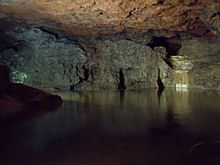|
|
|
|
Clearwell CavesAncient Mine / Quarry
|
||||||||||||||||||||||||
|
|
|
Images (click to view fullsize) |
|

|
Fieldnotes |
|
|
Have wanted to visit this place for some time and today was the day. “Clearwell Caves are part of an extensive natural cave system that became partially filled with iron ore 180,000,000 years ago. No one knows when mining for iron ore first began in the Forest of Dean, but the Caves are one of the earliest mines in the British Isles, begun well over 4,000 years ago, when they were first worked for coloured iron oxide or ochres to use as pigment.” (information taken from Visitor’s Guide) The temperature inside the caves is 10 degrees (which is also the temperature at which spring water emerges from the ground) so take an extra layer if you go on a warm day. We only went to the upper level which goes down 100 feet – it is possible to descend to a much deeper level but this requires hard hats, protective clothing and a caving guide. The caves are a series of caverns known as churns, linked together by tunnels, the largest of which is Pillar Churn named after a large column of stone in the centre. The reservoir in this cavern controls the water that seeps through a disused shaft in the roof. The large flat roof is composed of a very solid rock known as Whitehead Limestone, referred to as ‘lidstone’ because it forms the roof of most of the caverns. There is a fine example of 20th century cave art on the wall in this cavern – a skeleton painted by students in the 1960s. Clearwell Caves are home to a variety of bats including the greater horseshoe, natterers, and long-eared but the most numerous is the lesser horseshoe (ref: Visitor’s Guide). None made an appearance today. Also found here is the ‘Meta menardi’ or European Cave Spider (an orb-weaving spider) – didn’t see one of those either. Just as fascinating is the nearby ‘Secret Forest’ which is full of ‘scowles’ ie ravines and rock formations overhung with the tree roots of ancient yews. Thought to be where iron mining began, just outside the wood there are some replica Iron Age round houses which are definitely worth a visit. http://secretforest.co.uk/ A short distance up the road is Puzzle Wood, similar to the Secret Forest but far more disorientating, like caves above rather than below ground, very twisty and dark (believed to have inspired Tolkien’s Middle Earth) again the temperature dropped considerably - almost like being in caves. Unfortunately, today I left my camera at home so no photos except the ones on my friend’s camera which I don’t have access to as yet. |
 Posted by tjj
Posted by tjj1st July 2013ce Edited 3rd July 2013ce |
|
I visited the caves a couple of years ago with Karen and Dafydd. The caves are well sign posted from the A48 and have a large car park, shop/café, toilets etc. The visitor's guide states that the caves have been in use since the Bronze Age. The self-guide tour is an easy walk and we were able to take the push chair all the way around – about a 45 minute walk. All in all we spent a good afternoon here. A visit I would recommend. |
Posted by CARL 20th June 2011ce |
Links |
|
YouTubeMichaela Strachan relates some spooky stories (and what sounds like the coblynau) in her 'Great British Ghosts' series (begins 13 minutes in). |
 Posted by Rhiannon
Posted by Rhiannon1st September 2013ce |
Clearwell Caves - ancient ochre and iron ore mineOchre and iron ore mined here for thousands of years. |
 Posted by tjj
Posted by tjj7th February 2013ce Edited 7th February 2013ce |

